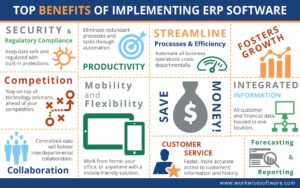ERP System
Enterprise resource planning or ERP software is a suite of applications that manages core business processes, such as sales, purchasing, accounting, human resource, customer support, CRM and inventory. It’s an integrated system as opposed to individual software designed specifically for business process.
ERP software solutions have increasingly gained traction among enterprises both big and small for its centralized approach to business processes. With it, you can collect, store, manage, and interpret data from various business units. Likewise, ERP is used to automate back-office tasks and streamline cross-departmental workflows. When optimized, the solution can drive efficiency, lower costs and increase profitability.

However, there are still plenty of companies who have yet to invest in one primarily because they are unaware of what it can do as well as what to expect when implementing one. If you are one of these companies, well, you’re in luck. We have prepared an in-depth analysis of the features, types, and benefits that these ERP programs have to offer. In addition, we’ve presented how ERP systems are typically priced so you have an idea how it impacts the budget, and listed down some examples that you might want to consider as you browse for one for your company.
Beyond answering the question of what is ERP software, you should also know why you need it. The purpose of ERP software is to increase efficiency, streamline processes and promote a culture of collaboration in the organization. This results in minimized costs and increased productivity which can eventually lead to a better bottom line.

Let’s break down the advantages of ERP software:
-
It Increases Efficiency
Business processes like accounting, sales, marketing, production, and inventory are integrated in one ERP platform. It’s easier to collect and access data across the organization, streamlining cross-departmental workflows.
Likewise, ERP automates day-to-day tasks like entering data or generating reports. Repetitive processes are eliminated, freeing teams to focus on their core deliverables. For instance, marketing can run a daily web traffic report without bugging tech; or, accounting can instantly access the week’s sales stats without chasing the sales director.
ERP also provides managers and key stakeholders with quick look-ups. Dashboards allow decision-makers to glance at key performance indicators across the organization. If they want to investigate more, managers can drill down to details in a few clicks.
-
It Promotes Collaboration
ERP breaks down walls between departments. Data silos are integrated and a process superhighway links local workstations together. This setup allows teams that used to operate in a vacuum to easily collaborate with other teams inside the ERP platform.
Moreover, SaaS ERP further extends collaboration between remote teams and headquarters through the internet. Offshore business units are now within earshot of their mother unit. A culture of collaboration drives innovation and team play and, in general, makes businesses more competitive.
-
It Increases Data Security
ERP solutions have firewalls and restriction controls to guard against data breach. Having a single data warehouse means access points are tightly monitored and security is concentrated. Likewise, user permission rules give the admin the flexibility to lock in sensitive data without limiting user access to other information.
Administrators can also quickly deactivate the access of terminated employees and grant permission to new ones. ERP solutions also display user activities, so you can easily spot unauthorized actions or suspicious activity patterns in the system.
-
It Helps You Comply with Industry Regulations
Many ERP solutions feature built-in regulatory process standards and compliance reporting to help businesses meet myriad business requirements. ERP solutions subscribe to reporting protocols for aspects like financial accounting, product regulations and data security.
-
It Allows You to Make Accurate Forecasts
The only worse thing about the lack of a forecast is a wrong one. Forecasts shape strategies; thus, it’s crucial organizations get the real picture. Using a centralized database, ERP lends to a company’s disparate business solutions a standardized process, ultimately, enhancing data integrity.
ERP reporting tools use advanced filters and analytics to sift data for inconsistencies. Features of ERP software like deduplication also ensures data is updated and duplicate-free. With data integrity intact, managers can generate reports with realistic forecasts. Similarly, estimates are within a sensible range of outcomes.
Moreover, advanced ERP solutions with business intelligence tools use machine learning and predictive algorithm that allow users to dig deep into big data. Companies with complex data sources can leverage ERP for hidden insights and gain a competitive edge.
-
It Increases Operational Flexibility
SaaS ERP also gives you a means to increase operational flexibility. For one, it helps you integrate existing apps to your system or export your ERP data to other business apps for a more streamlined workflow. Secondly, most of these give you the option to add more modules as your business grows so that you no longer need to replace your system with a new software. Lastly, SaaS ERP gives you mobility as it can often be accessed on any device so long as it is connected to the internet.
-
It Reduces Operational Costs
A company can also leverage ERP to cut down costs. When processes are streamlined and key metrics are closely monitored, disruptions, delays and breakdowns are anticipated or its impact better managed.
Manufacturing and distribution are especially vulnerable to disruption. But with ERP allowing production, engineering, customer service and other business units to work closely together using real-time data, resolving sudden problems is faster. Operating costs are kept within budget.
To add to these, ERP software providers often takes care of patches, gives regular updates, and handles troubleshooting in case of technical problems. This means you don’t have to worry about maintenance costs.
